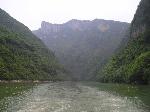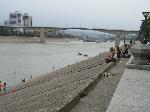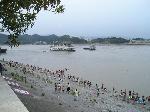- Getting around Lijiang. Dont stay in the Old Towns more than 2 days, there is nothing to do. KRISS Oct 9, 2013 05:46
- 2013 Beijing Temple Fair BENNYLAU Feb 26, 2013 03:29
- Malaysian traveling from KUL - LAX vis Shanghai PVG ZATI_DY Jan 3, 2013 20:15
Prosperous in the Shadow
- Views: 4796
- |Vote: 1 0
- |Add to Favorites
- |Recommend to Friends
Building a dam on any river is usually a significant engineering feat but building a dam on the third largest river in the world is a massive undertaking. Work first began on the Three Gorges Project back in December 1970 with the first of two dams completed in 1988. The 2.6 km wide Gezhou Dam holding back a lake 32 kms long, lies in the western suburbs of Yichang and today generates hydro-electricity for cities in the Yangtze valley while controlling flood waters that once devastated the lower reaches of the river on an annual basis. The second massive dam with a lock drop of a 100mts is nearing completion just 38 kms upstream in the beautiful Xiling Gorge at Sanduoping and I was excited about passing this way again - this time in the hydrofoil.
We had chosen to take the hydrofoil after discovering how quick, convenient and comfortable the service was - from Badong this was especially so as the roads out of town are notoriously dangerous as they wind their way slowly through this rugged mountain massif. We left Badong just after lunch on the 2.00pm boat, excited about passing through the new dam and locks in the daylight hours. On my last trip downriver our cruise ship arrived at the dam just on dusk. We passed through the locks after dark continuing through the remainder of the Xiling Gorge, and what I consider the most stunning of the three under a bright moonlit sky arriving in Yichang, as most of the tour boats do, at two in the morning. I was then rushed ashore, taxied to my hotel from which I was aroused early in the morning to catch a 7.00am bus, so I never did get to see Yichang.
Now we were in for a few unexpected surprises this afternoon. The hydrofoil is smooth and fast and after little more than an hour cruising through Xiling Gorge the flow of the river slowed and her banks spread considerably. We slowed our pace and drew into a landing on the northern shore where we were instructed to disembark. It was obvious that we had arrived at Sanduoping, the site of the new Three Gorges Dam, 40kms upstream from Yichang and that the hydrofoil would go no further. Obviously disappointed, but curious now as to how we were going to get to Yichang if this was the end of the line for the hydrofoil, we followed the other passengers into the funicular that carried us up to the top of the slope through the terminal and outside to waiting buses.
There was a little confusion as everyone scrambled for seats but we were quickly on our way, craning out the window for any glimpse of the ‘DaBa’ the big dam, as it is affectionately called by the locals. From the bus it was difficult to see much of anything with many of the curtains typically drawn to keep out the heat of the afternoon sun. A public bus from Yichang will get you back out here and guided tours are readily available allowing visitors to get up close to the dam site. If you’re cruising in style you won’t miss this experience as all the cruise ships will pass through the locks with their impressive 100 meters drop.
A little disappointed that our river journey had ended, we turned our attention to the scenery that was unfolding ahead of us. Again the river narrowed and cliffs overshadowed the valley to the north and south. This was what I had seen on that moonlit night three years before as I lay on my bunk, gazing out the window with my ship rolling in the turbulent eddies and currents of the river. The road began to climb giving us an even better view from several hundred meters above the water. We passed through more than six long tunnels, and many bridges spanning small streams and valleys, some hiding resorts and scenic spots before making the long steady decent into Yichang.
Like most cities Yichang has several bus stations and we had no idea where we would be arriving because we had expected to travel all the way on the river. When we emerged from the bus station I made inquiries for the train station since our hotel was close by and was pleasantly surprised to find that it was just up the street. The hotel would be within walking distance – in fact it was less than 100 metres up the street so we checked in and headed out to have a look around the city before dark. It’s not a big place and we jumped on a bus heading down to the river naturally and arrived just upstream form the entrance to the lock-shipping channel of the older Gezhou dam. The river here is broad and naturally flows more sedately. Did I mention how hot it was? Still muddy brown with silt this does not deter the locals from swimming. We promenaded on the boardwalk along the northern shore with hundreds of residents walking, some with their dogs and others with children enjoying the cool breeze off the river as the heat of the sun began to fade.
Here the Yangtze River makes a large sweeping bend from the north to flow again eastward toward the sea and a well-wooded park and boardwalk extend for several kilometers along the riverbank interspersed with docks for loading and unloading cargo ships with the main passenger and ferry terminals on Yanjiang Avenue up near the Dagong Bridge. A constant stream of shipping passes by - more than 60% of all river transport passes through here feeding the vast south west of the country and the journey is still sometimes fraught with dangers. Down the stepped concrete riverbanks local residents stood ankle deep or swam in the filthy but cool waters at the end another hot sticky summers day. A police boat patrols just off shore and we can see the heads of several people swimming across the shipping channel from the island timing their swim between the fleets of barges that emerge from or enter the channel.
Much of Yichang’s waterfront is undergoing a facelift and it is possibly her most valuable asset and her greatest attraction. Tastefully designed and situated new apartments are springing up like mushrooms taking advantage of the river views. As you wander through the park you’ll find plenty to entertain you and there’s a quaint teahouse located in an old building that may once have been a temple - made of timber with tiled roofs, flying eaves and an art gallery to momentarily escape the summer heat. The esplanade itself is also being upgraded. Across the street outdoor dining is not only popular but the best way to enjoy Yichang’s abundant variety of hot spicy seafood dishes. We couldn’t decide on what we’d like to try so we passed for something plainer. Western style restaurants, bars and coffee shops are plentiful in the Yunji Lu area.
Darkness had fallen as we searched the modern neon lit streets lined with bars and restaurants looking for somewhere to eat. A light shower forced us off the street and we found ourselves in a restaurant popular with some of the local foreigners. There seemed to be more of us than local Chinese and the food was good and simple after a long hot day on the river. After dinner we wandered back to our room in the light refreshing drizzle.
Yichang, like many Chinese cities has had several names during her long and turbulent history. Names in many ancient cultures were carefully chosen to reflect the future prosperity, the quality or character of the recipient. Not only people’s names but also place names throughout China often reflect the historical importance or role of a city in the history of the country. And so it is today with Yichang whose name literally translates – ‘should prosper’– and this has certainly become a reality for Yichang in recent years. It hasn’t always been the case though, as this strategically located river city has been a target of warring factions vying for control of its important trade and transport waterways during times when China was politically divided. More recently it fell to the Japanese in 1940 and by the end of their occupation the city’s trade and economy was ruined. Since the end of the war, shipping increased and with industrialization Yichang’s prosperity grew.
Yichang was also opened as a treaty port to foreigners in 1877 with a foreign concession built to the southeast of the old walled city, which today is all but gone. Yichang can now boast good connections with the rest of the country by air, rail, road and river – the latter still the only way to see all three of these impressive gorges. Yichang’s face may be changing, modernizing but she will always be a port city, her character built over the centuries of servicing boats, cargo, crew and passengers before or after they made their journey through the now famous, but always-treacherous Three Gorges section of the river. Today Yichang sits patiently in the shadow of this now famous tourist attraction and her future indeed looks prosperous.









 Copyright © 1998-2025 All rights reserved.
Copyright © 1998-2025 All rights reserved.